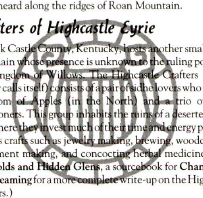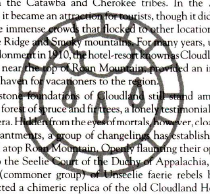Finally, we enter the double digits of episodes (well, unless you count our introductory one) as we discuss Rage Across Appalachia. Despite the cover art, the font and border styles, and the overwhelming majority of the content all suggesting this is a supplement for Werewolf: the Apocalypse, there is in fact the note that says it’s also intended for Changeling: the Dreaming. Ergo, we’re including it in our Lost in the Library series of book dives—however, this ended up being kind of a mini-sode, because really the entirety of the Changeling content fits into one chapter and some extra pages for the whole book. Still, we get some useful pieces, including the first substantive information on the Nunnehi, the Indigenous fae of the continent.
somewhere in the dreaming… freehold heraldry
Moving forward, the “Somewhere in the Dreaming” tag will be useful for instances where we speculate on alternate directions the Changeling universe might’ve gone, when we see hints of a decision about the canon briefly showing up in one book, and then disappearing again with little if any trace. In an alternate dimension—or a Dream Realm of some kind—perhaps there is a shape of the game-that-could’ve-been that contains some of these elements. And in the case of Rage Across Appalachia, there are two freeholds (Roan Mountain and Highcastle Eyrie) that have their own stained-glass style crests, as each of the kiths do. (Pooka was going to attempt to work some Photoshop magic and extract the line drawings to create a mockup of each, but they didn’t have time, for even sorcery must give way to temporal logic in the absence of Chronos.)


What this suggests to us is that in some other version of Changeling, there are icons like this for each and every freehold, and an entire system of heraldry based around fae affiliations with them. Boggans with a head for memorizing all this shit could be there at tourneys or pitched battles announcing the representative from this-or-that freehold, the pennons of each minor knight could feature the design, and so on. If you’re thinking, “but there would be hundreds to thousands of such icons!” just… just look at how bonkers the system of European heraldry got, historically. However, it might be too much for the artists and designers of the game, so if this was ever a possibility, it’s easy to see why it got cut. Still, though…
…
ballads and bluegrass and reelbands (oh my)
When you grow up with folk and traditional music, you learn about how important ballads are for passing along stories, warnings, wisdom, feuds, history, and so on. The oral tradition is alive and well, even if we don’t always know its shape when we’re living in the middle of it. (Maybe memes and the explanations for why they’re funny will be what we pass down in the future.) Rage Across Appalachia has a nice little section in the Appendix where they talk about how to leverage these into a game—not just in the Appalachian setting, but it works quite well there—as sources of information and inspiration. Lots of this stuff is already scattered through the canon, because a nonzero number of the line’s authors have been musicians of different sorts, sometimes (we believe?) in these genres. But just for an example, here’s a classic about a noble vs. commoner duel:
This kind of stuff makes good background music for a game with the right vibe; it’s especially nice when you can get tracks from local acts (which are unfortunately kind of a pain to find online, if you have specific bands that, say, you went to see at the Renaissance Faire every year as a kid). The corpus for this music is vast, and extends far beyond the Celtic-immigrant-inflected flavor that this book in particular goes for. Check out traditional music where you can, and you’ll find ways it can be incorporated into your chronicle, as both plot hook and atmosphere.
…
nunnehi research
As we mention in the episode: we’re both white folks, with little personal connection to Indigenous groups or issues, so we’re doing our best to handle them delicately as they come up in our read of these books. While we’re glad to see the Nunnehi evolve in this book beyond the mentions they had in earlier ones (i.e., raiding war parties and nothing else), they’re still a way off from really being three-dimensional to the degree that other changelings in the game are.
Something important to bear in mind when dealing with the Nunnehi as a player or Storyteller who’s not of Indigenous background is to ask yourself, why is it important to play/feature this character? Closely following that question in importance is, what research do I need to do? The answer to the first one should always be something more substantial than just “because they’re cool,” and the answer to the second one is “probably more than you think.” Because citation is so rare on the internet, you can often find the same text over and over again, remixed and repurposed, but you may have no alternative unless you have an informant from the culture you’re interested in who’s willing to chat with you. (And if you do, be very up front about your reasons for that conversation.) In truth, you may not be able to separate the stuff that’s useful and correct from the stuff that’s not, and you’ll have to decide where the line is that you’re comfortable with.
Briefly, for these show notes and related to the kiths introduced in this book: some cursory digging on http://www.native-languages.org (co-organized by a Cherokee retiree, and an excellent group of linguistic resources overall) led to a collection of tidbits on the Nanehi (note that this seems to just be a variant of “Nunnehi”) and the Yunwi Tsundsi. For the Yunwi Amai’yine’hi, there are lots of recycled pieces around the internet (including on Wikipedia) from James Mooney’s Myths of the Cherokee (section 78), the text of which you can find here because it’s in the public domain. Given that it was written by a white ethnographer in 1900, take with a grain (or handful) of salt. And a lot of other pieces around the internet are… well, cribbed from Changeling, either overtly or more insidiously.
These are springboards and nothing more; we encourage you to keep digging as deeply and carefully as you can. If that helps you decide whether incorporating Nunnehi into your game is an appropriate thing to do, then good; and if you’re left unable to make a decision, at least you’ve tried to educate yourself further, which is rarely a bad idea. We encourage you to think about cultural appropriation in relation to Indigenous history, and how the act of using Indigenous lore in Changeling will place you in relation to that.
…
your hosts
Josh Hillerup (he/him) suggests the burrata with tomato, garlic, and pesto for the appetizer.
Pooka G (any pronoun/they) has already beaten you to the dessert cart and cleaned it out entirely.
…
“We all have forests on our minds. Forests unexplored, unending. Each one of us gets lost in the forest, every night, alone.” —Ursula K. LeGuin, The Wind’s Twelve Quarters
(psst! email us at podcast@changelingthepodcast.com if you want)
(and join our Discord at https://discord.gg/SAryjXGm5j !)
(support us on Patreon! it’s now live at https://www.patreon.com/changelingthepodcast)